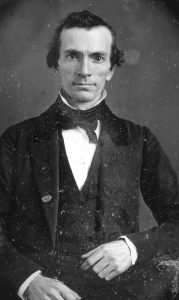COPYRIGHT 2026 SCRIPTURE CENTRAL FOUNDATION: A NON-PROFIT ORGANIZATION. ALL RIGHTS RESERVED. REGISTERED 501(C)(3). EIN: 39-2827600
Historical Context and Background of D&C 6

Video Overview
Brief Synopsis by Steven C. Harper
Early in 1829, Joseph’s father-in-law was about to evict him. Joseph “cried unto the Lord that he would provide for me to accomplish the work whereunto he had commanded me.”1 This prayer was answered on a Sabbath evening when Joseph’s younger brother Samuel arrived with a twenty-two-year-old school teacher named Oliver Cowdery.
Oliver had learned about the marvelous work from Joseph’s family. He had prayed to know the truth of the matter, and the Lord showed him the Book of Mormon plates in a vision and told him of the translation Joseph had begun.2 Oliver probably brought with him some money for Joseph to use to make a payment to his father-in-law.
On the second day after his arrival, Oliver began scribing as Joseph translated the Book of Mormon. Oliver had a normal inclination to fear and doubt things that had been revealed to him before. He wanted to know if he could believe what he was seeing and experiencing. The Lord responded with the reassuring revelation in section 6.
Speaking to Oliver through Joseph, the Lord assured Oliver that his gifts were indeed divine, as well as the revelation he received before. This had the effect of convincing Oliver once and for all that Joseph, however unrefined or lacking in literacy, was the Lord’s chosen seer, for out of Joseph’s mouth came the words of Jesus Christ, telling Oliver things Jesus knew but Joseph didn’t. Oliver wrote to David Whitmer, saying that Joseph had “told him secrets of his life that he knew could not be known to any person but himself, in any way other than by revelation from the Almighty.”3
Section 6 foreshadows sections 7 and 8 by telling Oliver about records that have been kept hidden due to wickedness and that Oliver can have the gift to translate if he desires it. The revelation foreshadows martyrdom, but it is encouraging and empowering to Oliver. It also bears a beautiful autobiographical witness of Christ, perhaps even in a visual way for Joseph and Oliver, the two young seers. The Lord invited them to “look unto me in every thought; doubt not, fear not. Behold the wounds which pierced my side, and also the prints of the nails in my hands and feet” (D&C 6:36–37). Like Peter, beholding the risen Christ gave Joseph and Oliver apostolic courage.
What we have in section 6, then, is a document of the Lord’s lovingly employed omniscience. He is not the arbitrary sovereign Oliver’s ancestors imagined him to be.4 He uses his limitless power to address the needs of those who desire and ask. He proved to Oliver that Joseph Smith, whatever his “faults” (v. 19), is the Lord’s chosen seer. The revelation not only says those things, but by its delivery through Joseph and its secrets known only to the Lord and Oliver, it illustrates them.
1. “History, circa Summer 1832,” p. [6], The Joseph Smith Papers, accessed July 22, 2020.
2. “History, circa Summer 1832,” p. [6], The Joseph Smith Papers, accessed July 22, 2020. “History, 1838–1856, volume A-1 [23 December 1805–30 August 1834],” p. 15, The Joseph Smith Papers, accessed July 22, 2020.
3. James H. Hart, “About the Book of Mormon,” Deseret News (Salt Lake City), April 9, 1884, 190; see also “Report of Elders Orson Pratt and Joseph F. Smith,” Deseret News, November 27, 1878, 674.
4. In his famous 1741 sermon, “Sinners in the Hands of an Angry God,” Jonathan Edwards described “the mere pleasure of God, I mean his sovereign pleasure, his arbitrary will, restrained by no obligation.” John E. Smith, Harry S. Stout, and Kenneth P. Minkema, editors, A Jonathan Edwards Reader (New Haven: Yale University Press, 1995), 90.
Additional Context by Casey Paul Griffiths
From Doctrine and Covenants Minute
Doctrine and Covenants 6 introduces us to one of the most important figures in the saga of the Restoration. On the Sabbath evening of April 5, Oliver Cowdery and Samuel H. Smith both arrived in Harmony, Pennsylvania. Oliver had moved to Palmyra the previous fall and while boarding with the Smith family became aware of the plates and of Joseph Smith’s prophetic call. At the time, Joseph was struggling to restart the translation of the Book of Mormon. Lucy Mack Smith later recalled, “Joseph has been so hurried with his secular affairs, that he could not proceed with his spiritual concerns so fast as was necessary for the speedy completion of the work.” During this period Emma acted as scribe when she was able, but she “had so much of her time taken up with the care of the house, that she could write for but a small portion of the time.” In response to these pressures, “Joseph called upon the Lord, three days prior to the arrival of Samuel and Oliver, to send him a scribe, according to the promise of the angel; and he was informed that the same should be forthcoming in a few days. Accordingly, when Mr. Cowdery told him the business he had come upon, Joseph was not at all surprised” (Lucy Mack Smith History, 1844–1845, bk. 8, 4, JSP). Though we do not know the exact date on which this revelation was received, it appears to have been shortly after Oliver arrived in Harmony. The connection between Joseph and Oliver was immediate. In an 1834 letter to W. W. Phelps, Oliver notes that he arrived in Harmony on April 5 and then commenced his work as scribe of the translation just two days later, on April 7, 1829 (“Letter I,” Latter-day Saints’ Messenger and Advocate, October 1834, 1:13–16).